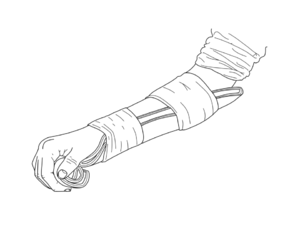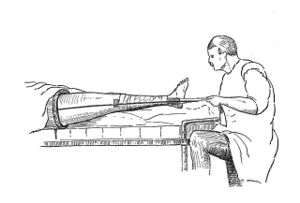Splinting: Difference between revisions
No edit summary |
No edit summary |
||
| Line 9: | Line 9: | ||
== Introduction == | == Introduction == | ||
A splint is a rigid or flexible device that maintains in position a displaced or movable part, also used to keep in place and protect an injured part<ref>VanBlarcom CW, editor. [https://www.thejpd.org/article/S0022-3913(99)70234-9/fulltext The glossary of prosthodontic terms]. Mosby; 1999.</ref> to support healing, and to prevent further damage<ref>Althoff AD, Reeves RA. [https://www.ncbi.nlm.nih.gov/books/NBK557673/ Splinting]. StatPearls [Internet]. 2020 May 24.</ref>. | A splint is a rigid or flexible device that maintains in position a displaced or movable part, also used to keep in place and protect an injured part<ref>VanBlarcom CW, editor. [https://www.thejpd.org/article/S0022-3913(99)70234-9/fulltext The glossary of prosthodontic terms]. Mosby; 1999.</ref> to support healing, and to prevent further damage<ref>Althoff AD, Reeves RA. [https://www.ncbi.nlm.nih.gov/books/NBK557673/ Splinting]. StatPearls [Internet]. 2020 May 24.</ref>. | ||
[[File:Arm splint.png|alt=Image showing arm splint|center|thumb|Arm splint]] | |||
== '''Purpose of Splinting''' == | == '''Purpose of Splinting''' == | ||
[[File:Thomas's splint.jpg|thumb|Thomas's splint, commonly used for the immobilization of hip and thigh injuries]] | |||
* Pain relief –acute or chronic, i.e.- osteorthritis, rheumatoid arthritis, carpal tunnel syndrome | * Pain relief –acute or chronic, i.e.- osteorthritis, rheumatoid arthritis, carpal tunnel syndrome | ||
* Support/Position during function, i.e.- nerve palsy | * Support/Position during function, i.e.- nerve palsy | ||
Revision as of 17:59, 27 October 2020
This article is currently under construction and may only be partially complete. Please come back soon to see the finished work. Thank you! (27/10/2020)
Original Editor - Shwe Shwe U Marma
Top Contributors - {{Special:Contributors/Template:Splint}}
Introduction[edit | edit source]
A splint is a rigid or flexible device that maintains in position a displaced or movable part, also used to keep in place and protect an injured part[1] to support healing, and to prevent further damage[2].
Purpose of Splinting[edit | edit source]
- Pain relief –acute or chronic, i.e.- osteorthritis, rheumatoid arthritis, carpal tunnel syndrome
- Support/Position during function, i.e.- nerve palsy
- Protection/Immobilisation, i.e.- post open reduction internal fixation
- Prevention/Correction of deformity, i.e.- rheumatoid arthritis
- Edema control, i.e.- rheumatoid arthritis, osteoarthritis
- Maintenance/Restoration of range of motion, i.e.- tendon repair
- Scar remodeling, i.e.- burns
Different Types of Splints[edit | edit source]
Splints for upper limbs[3]
| Region | Type of splint |
|---|---|
| Ulnar side of hand | Ulnar gutter splint |
| Radial side of hand | Radial gutter splint |
| Thumb, first metacarpal, and carpal bones | Thumb spica splint |
| Finger injuries |
|
| Wrist/hand |
|
| Forearm | Single sugar-tong splint |
| Elbow, proximal forearm, and skeletally immature wrist injuries |
|
References[edit | edit source]
- ↑ VanBlarcom CW, editor. The glossary of prosthodontic terms. Mosby; 1999.
- ↑ Althoff AD, Reeves RA. Splinting. StatPearls [Internet]. 2020 May 24.
- ↑ Boyd AS, Benjamin HJ, Asplund CA. Splints and casts: indications and methods. American family physician. 2009 Sep 1;80(5):491-9.








